A CHOCOLATE FOOL: CLIMBING PICO DO SÃO TOMÉ AND PICO DO PRÍNCIPE

As an aging alpinist, my projects of late have been getting more modest. Therefore, to retain credibility with drinking mates, I’ve sought obscure peaks they’ve never heard of, leaving room for hyperbole. São Tomé and Príncipe’s highpoint perfectly fitted this bill. Indeed, some impressionable friends even assumed I was attempting Pico Cão Grande (Great Dog Peak), a snake-infested, 670m steeple that’s only been scaled by a few crack climbers – and there seemed no point disillusioning them.
Some 200km off Gabon and almost on the equator, São Tomé and Príncipe together form Africa’s second smallest nation (after the Seychelles). On the flight from Lisbon, I was accompanied by my wife Fiona, who was looking forward to lounging on tranquil beaches, and heading for disappointment. Otherwise, there weren’t many ‘brancos’ aboard.
We landed on São Tomé, the largest isle and home to most of the 200,000 citizens. Also named after the doubting apostle, the capital city was draped along a bay on the northeast coast. A few colonial buildings still looked impressive, such as the President’s palace, but most were dilapidated and boarded up. The modern offices generally belonged to banks, whose ATMs wouldn’t dispense me any Dobras, but everybody preferred Euros.
The National Museum occupied a squat, custard-coloured fort. Outside, were statues of the two Portuguese explorers who discovered this uninhabited island on St Thomas’s Day, 1471, and Príncipe three weeks later; alongside the first Portuguese governor sent to exploit them, which led to the import of sugarcane and slaves. Standing apart was a bust of Amador Viera, who led a slave rebellion, before being captured, hanged and quartered.

The museum’s interior wasn’t overflowing with exhibits, but we got the gist. There was a room dedicated to cocoa, which was introduced in 1819 to great effect, with São Tomé and Príncipe becoming the world’s biggest producer, nicknamed the Chocolate Islands. There was a room stocked with fancy colonial furniture; and another with grainy photographs of tortured Black Africans, for even after slavery was abolished in 1868, working conditions remained harsh for the indentured labourers brought from Portugal’s other African colonies. Meanwhile, on the upper floor were portraits of the politicos who took over on independence in 1975 and imposed a Marxist-Leninist state; though they might have been of the politicos who introduced democracy in the 1980s, but there was no interpretative text.
Characteristically, my wife wanted to visit Claudio Corallo’s Chocolate Factory, which offered tasting sessions of the ‘best chocolate in the world’, but it was closed. So, instead, we visited Roça Agostinho Neto, once one of the world’s most productive cocoa plantations. The ‘roça’ had seen better days. Descendants of indentured labourers still inhabited the squalid dorms, several families to a room; while it looked like the former hospital had been blitzed and the garbage not collected since the Portuguese left. An engineer once told me the definition of civilisation is ‘maintenance’, and being more artistically inclined, I scoffed - but here I could appreciate what he meant.
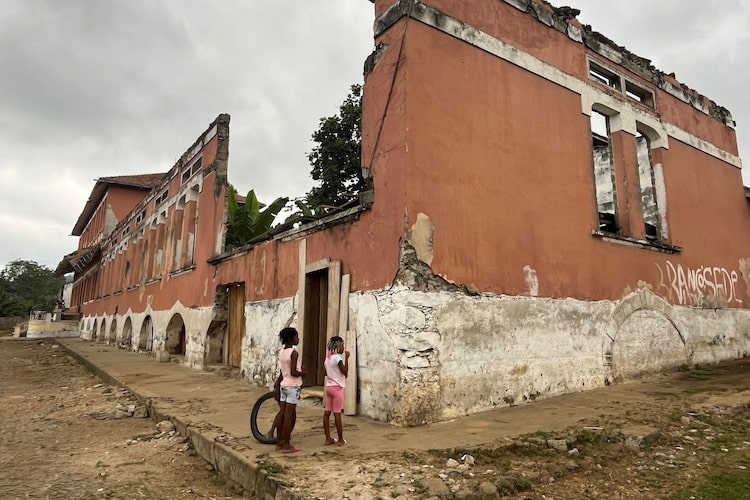
Driving around the north coast on potholed roads, we saw collapsed jetties and derelict villas, coconut palms and baobabs, black beaches, azure coves, and fishermen in dugout canoes bobbing in the swell. I’d also hoped to spot our target, but it was enveloped in ‘leite de voador’ – or flying fish milk - as locals term the almost-permanent cloud swaddling their highest mountain. Now generally, if unimaginatively, called Pico do São Tomé, it was previously named after Gago Coutinho, the Portuguese naval officer who made the first recorded ascent in 1916, on a cartological mission. The 2024m-high summit undramatically resembles a clothes-iron in shape, which I can’t contradict, since I never saw it.
We checked into Mucumbli Lodge, a haven of tranquillity and tidiness, with half a dozen staff sweeping up fallen leaves. Our wooden chalet overlooked a black lava beach described by the lodge blurb as ‘calm’ and ‘perfect for swimming’, where I nearly drowned in the roiling shingle. It was much calmer up on our terrace, watching the sun’s golden orb sink into the Atlantic.
The lodge had organised our trek, including two local guides, who turned up the following dawn. Josias spoke good English, while Abrão didn’t but knew the flora and fauna. Both were fit, good-humoured and in their mid-twenties, making them senior citizens in a country where two-fifths of the population is under 15. Before departing, Fiona diligently checked the weather forecast with the lodge’s receptionist. ‘Now is dry season,’ she answered, ‘but some days it rain’.
A half-hour jeep ride took us up to Ponta Figo, another neglected colonial plantation, at 450m elevation, from where we started walking. The first couple of hours were a mellow plod, on crumbling cobbled roads past scarlet coral trees, crimson cocoa pods and green bananas. The higher we got, the fainter the signs of continued cultivation, and by 1000m the last vestiges of the plantation had been consumed by encroaching forest. Trees stood triumphantly atop ruined buildings, their roots wrapped like tentacles around collapsed walls.
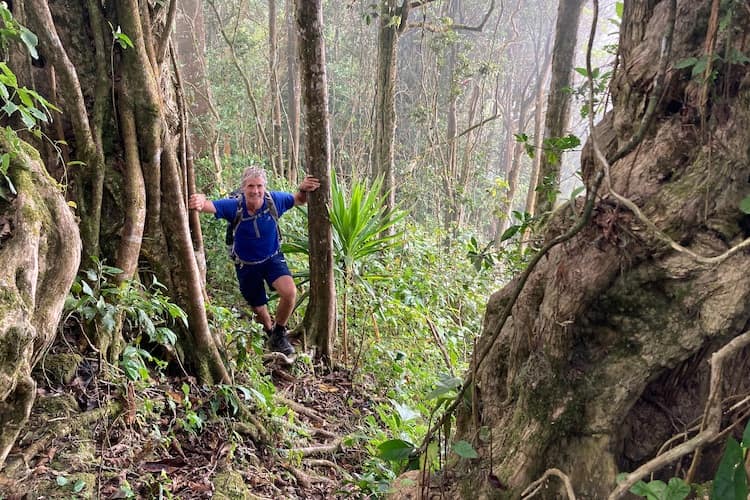
Beyond here we entered primary rainforest, and a dense tangle of ancient trees, flared roots, giant ferns, lianas, lichens, orchids and epiphytes. The sharp-eyed Abrão regularly pointed out Mona monkeys swinging through the canopy above, but all I ever saw was a trail of shaking branches. At noon, after five hours, we reached a clearing at 1900m, known as Pico Mesa, hosting a battered wooden gazebo.
From here was only 40 minutes to the top, but it required full attention, along a slender ridge, hauling on roots, shimmying round trunks, above disconcerting drops. Then, abruptly, we stumbled upon a chipped concrete beacon commemorating Coutinho’s inaugural ascent. With flying fish milk lapping at our feet, the panorama was just empty blue sky, which at least confirmed we’d reached the highest point. A separate plaque bore faint lettering in Portuguese which, according to Josias, was a testimony from Coutinho bemoaning his torrid climb.
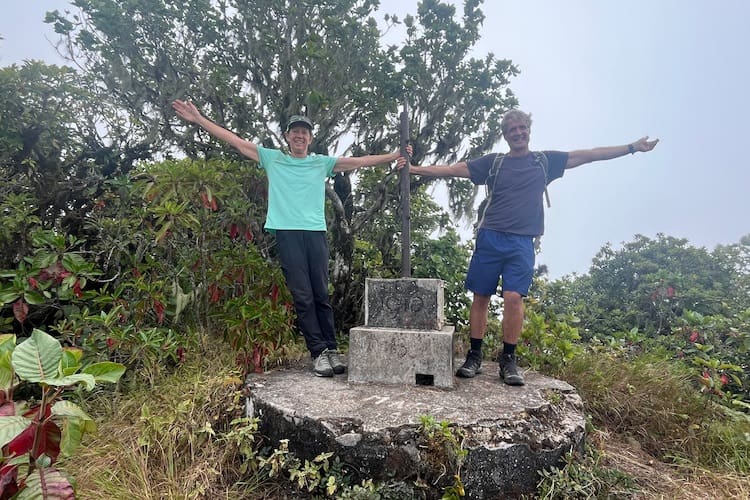
After gingerly retracing our way back down to Pico Mesa, we erected our cosy tent and settled in as best we could. And though Josias rustled up several helpings of spagbol, it was still a long equatorial night. In the morning, we ventured back along the ridge fruitlessly seeking a view, and Josias admitted that on nine prior visits he’d never had one.
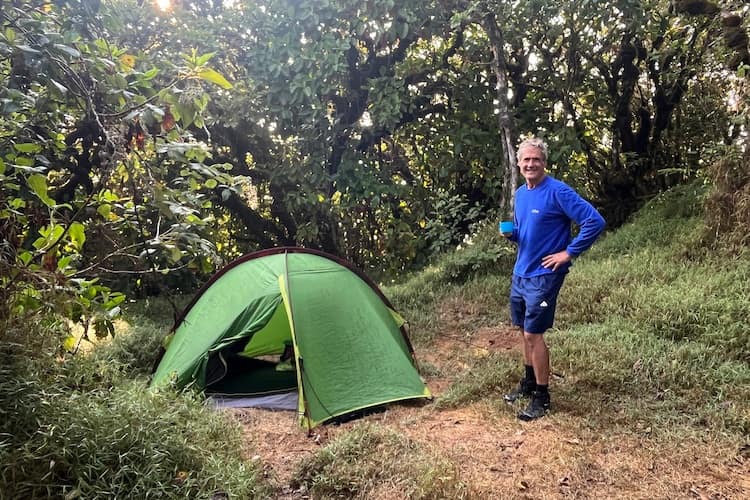
The descent was swift and largely controlled, with only one major alarm. As I swung Tarzan-like from a branch, a snake flicked my shoulder, eliciting a squeal and forward roll. São Tomé’s black Cobra Preta grows to three metres in length, with its bite leaving you just two hours to find anti-venom before fatal paralysis sets in. While I checked for fang marks, Abrão grinned, but how was I to know it was a harmless green snake.
Down at Ponta Figo, we duck-walked through an aqueduct tunnel built by the Portuguese and now home to bats, to emerge in a glade where we bathed under a 20m waterfall, which was far safer than swimming at Mucumbli beach. And that evening, back at the lodge, we celebrated with tuna calulú, cuttlefish risotto, gin tonics, Super Bocks and a bottle of Vinho Verde. Some might have said we’d already had enough, but we decided to also bag Príncipe’s highest peak.
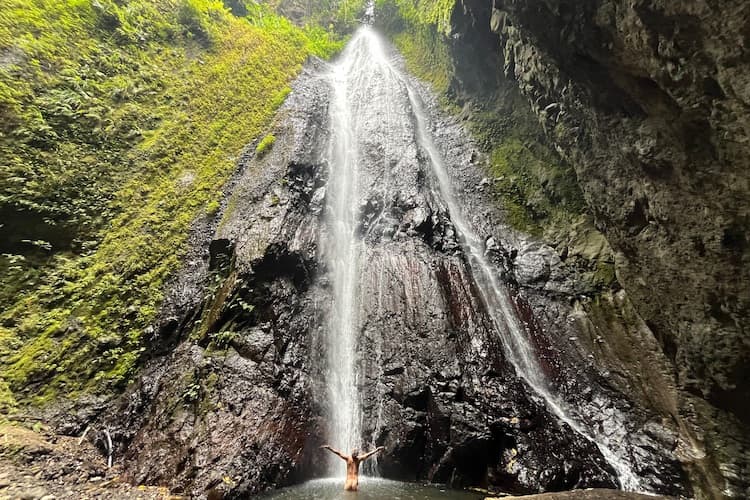
Organising logistics at short notice proved stressful. The Santomean life mantra ‘leve-leve’ is a charming philosophy, unless you’re trying to get anything done, in which case it’s bad for your blood pressure. Fortunately, the lodge manager was worried about his bar running dry and tracked down a contact on Príncipe.
Some 160km northeast from São Tomé, Príncipe is very much the junior island, just 15km long and with under 9000 residents, whom the Santomeans refer to as ‘moncós’ (simpletons). As the small, twin-prop plane banked to land, we spotted the exclusive Bom Bom Resort, owned by South African tech entrepreneur and astronaut Mark Shuttleworth. According to moncós, after spotting Príncipe’s green dot from his rocket, ‘the Man in the Moon’ decided to live there. And having prevented the ‘ilha verde’ being turned into a palm oil plantation, he stepped into the economic breach, opening three luxury hotels and employing most of the population.
We called in at Roça Sundy, formerly a plantation, and now one such resort. In May 1919, before its upgrading, British astronomer Arthur Eddington stayed here to photograph stars during a solar eclipse and thereby prove Albert Einstein’s Theory of Relativity. The specifics of gravitational lensing and frame-dragging escaped me, but I understood the colourful mural commemorating the experiment’s centenary. On the way out we visited the Promised Land, a newly built township to which the former residents of Roça Sundy had been relocated. Women and children toiled up the road with buckets of water on their heads, and some laws of relativity you didn’t have to be Einstein to spot.
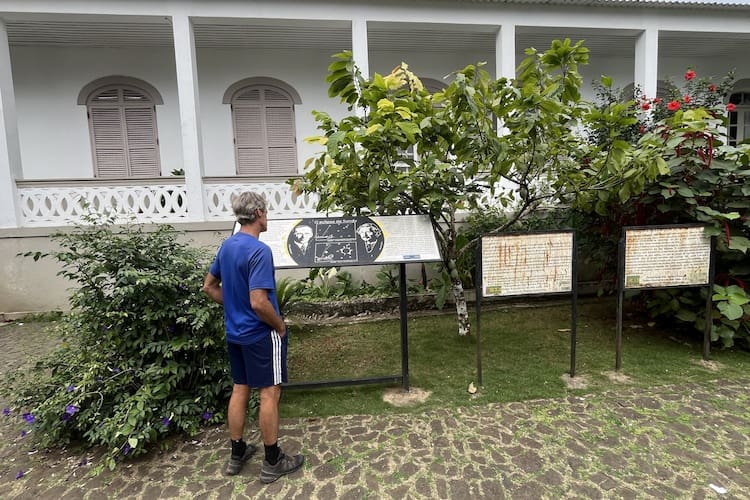
With Shuttleworth’s hospitality beyond our expedition budget, we installed ourselves in less salubrious lodgings above a supermarket in Santo António. The isle’s tiny capital and only settlement of note was huddled in a deep bay on the east coast, beneath cloud-covered peaks and dissected by the sluggish Parrot River. We’d expected the town to be similarly lethargic but instead found it pumping.
Our arrival had coincided with the annual fiesta, Auto de Floripes, when locals act out a medieval battle between Emperor Charlemagne’s Christian army and the invading Muslim Moors. Directed by their commanders perched on wooden mini-castles at opposite ends of the street, and egged on by an inebriated crowd, the two armies stomped back and forth, clashing shields and incurring several casualties, that might have been part of the plot. The cast were all male, except for Floripes who, according to tradition, must be played by a virgin maiden - which, given that the legal age for marriage is 14, might present difficulties. Imported from Portugal during colonial times, the play supposedly portrays good trumping evil - and, if neither historically nor politically correct, made an entertaining spectacle. Indeed, we considered ourselves highly fortunate to have caught it, until we retired to bed and the fiesta continued at full blast till dawn, by which time we’d been collected by our local guide, Zeze.
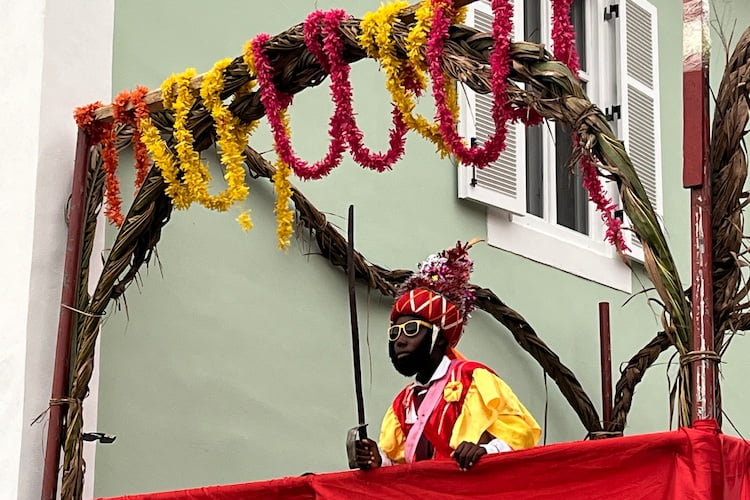
Though Pico do Príncipe was only seven kilometres southwest of Santo António, reaching the trailhead required 30 minutes of spinal traction in the back of Zeze’s jeep. A muddy, rutted track led up to the neglected plantation at São Joaquim, where Zeze parked amidst a dozen ragamuffins haphazardly booting a deflated football. (In case you’re wondering, the ‘Warriors of the Equator’ currently stand 195th out of 210 in the FIFA world rankings, eight places above the Seychelles.)
Standing 947m, Pico do Príncipe is reputedly an impressive phonolite tower, which I can’t confirm, since I never saw it. Its climbing provenance is vague, with a handful of scientific expeditions having ventured up, but few others. ‘You’re my first clients to go there,’ laughed Zeze, adding he had no intention of accompanying us. He had, however, secured the services of Monuna, a veteran forester who’d guided up several said scientists; and Monuna’s son, Suek, to add more machete and muscle.
Initially, the trail was well-marked and, with only 800m of elevation to gain, I brimmed with confidence. That soon evaporated, however, when we lost 100m in height descending to a river, and shortly thereafter the path. And while we sporadically found it again, those moments were brief. Wrapped in damp mist, we clambered over an obstacle course of landslides, toppled trees, tangled vines and slimy boulders. Neither Monuna nor Suek spoke English, so we just followed in their tracks, trying to avoid being dismembered by their slashing machetes. An ornithologist friend had insisted I look out for Príncipe’s endemic whydahs, noddies, drongos and boobies, but I was preoccupied surviving. After four sweaty hours crawling up spurs and slithering down gullies, we surprisingly popped out on top.

The summit clearing had just enough space for the four of us, with vegetated borders overhanging big drops - though I couldn’t tell you how big, since we were engulfed in flying fish milk. I was just plopping myself down on the summit beacon when Suek pointed to the black cobra already bagging the spot, prompting a squeal and instant levitation. At which Suek laughed and gently brushed it off, for all snakes on Príncipe are non-venomous. The weathered beacon was blank, save for an attached card stating ‘Bruxelles 5500kms’, which was geographically correct, if little else. So, I’d climbed the highest peak on both Chocolate Isles and had no idea what either looked like. No matter, describing my heroics in the pub, I’d make it all up.

USEFUL CONTACTS
Mucumbli Lodge is a convenient base for climbing Pico do São Tomé, and can provide guides, transport and tents. Website: mucumbli.mydirectstay.com. Contact:
Local tour guide José ‘Zeze’ Monteiro can arrange hikes on Príncipe. Contact: WhatsApp +239 993 4011

